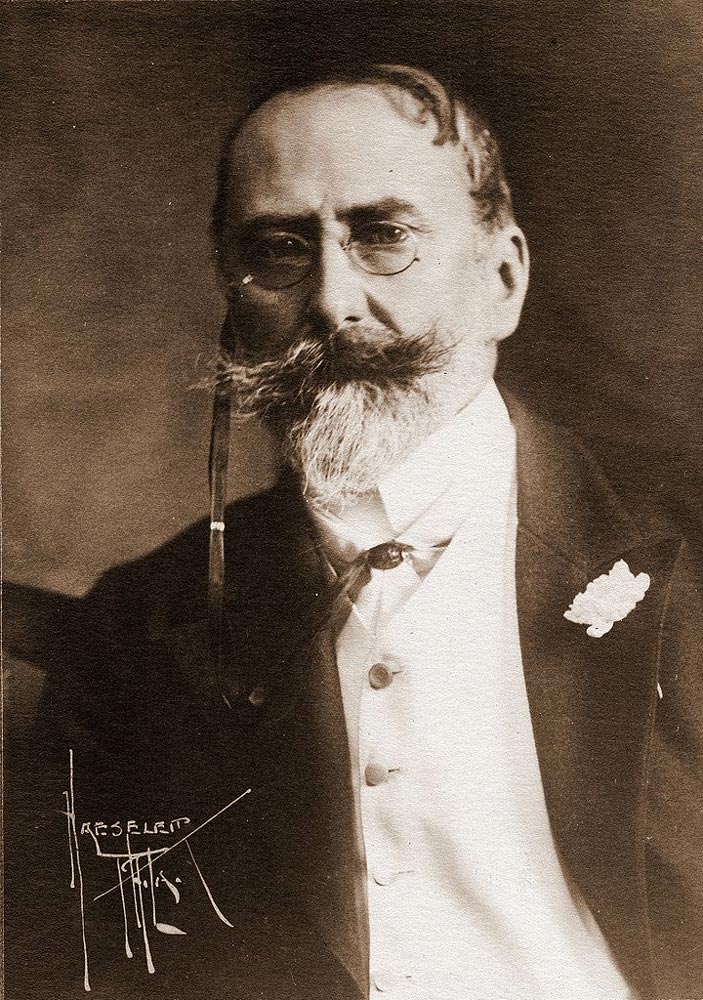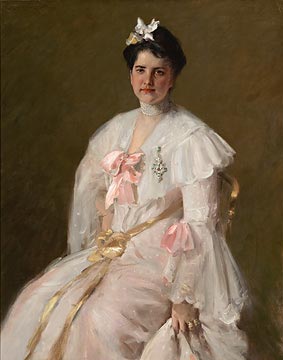| William Merritt Chase | |
|---|---|
 |
|
| Born | Nov. 1, 1849 Williamsburg (now Nineveh), Indiana |
| Died | Oct. 25, 1916 New York, New York |
| Nationality | American |
| Field | Painting |
| Works | View Complete Works |
William Merritt Chase (1849-1916) is considered by some, to be the most important American art teachers of his time. At the turn of the twentieth-century, he established schools which brought attention and interest to American art, and artists. Chase is known for his portraits, still lifes, and landscapes, which are created using French Impressionistic techniques. The impressionists techniques were promoted though his years of creating art, and teaching, allowing American artists to appreciate and create a new style of American Impressionism.
Early Interest in Art
William Merritt Chase was the first-born of six children, born in Williamsburg (now Nineveh), Indiana. With a desire to travel, and a passion for art, William resisted following his father into the shoe business, and pursued his artistic ambitions instead. The Chase family moved from Williamsburg, to Indianapolis, then to Saint Louis, Missouri. In 1867, William trained locally with Barton S. Hays, experienced a brief time in the Navy, then was encouraged to travel to New York, where he could further develop his artistic skills. In 1869, he moved to New York, to study at the National Academy of Design, but in 1870, moved back to Missouri in order to help support the family financially.
Beginning of a Lifelong Career
While in Saint Louis, Chase painted still-lifes professionally, attracting the attention of local people, who offered him a chance to study abroad in 1872. He entered the Royal Academy in Munich, Germany in 1872, studying for five years, yet keeping the doors open, to the American art world. He resided in Europe almost seven years, but during this time, exhibited his works at the National Academy of Design. In 1875, he was honored at the Centennial Exposition in Philadelphia, and in 1876, his painting The Court Jester was exhibited at the Boston Art Club. Winning critical acclaim for Ready for the Ride, in 1877, he returned to New York in 1878, and began teaching at the Art Students League until 1896.
Popularizing American Art through Teaching
 During this time of his artistic career, he founded the American Society of Painters in Pastel, and taught at several different schools. Chase taught at Shinnecock Summer School of Art on Long Island from 1890-1902, at the Brooklyn Art Association from 1887-1896, the Chase (New York) School of Art from 1896-1907, and the Pennsylvania Academy of the Fine Arts from 1896-1909, with returns to teaching at schools in various years. The Shinnecock Summer School and the New York School of art were founded by Chase.
During this time of his artistic career, he founded the American Society of Painters in Pastel, and taught at several different schools. Chase taught at Shinnecock Summer School of Art on Long Island from 1890-1902, at the Brooklyn Art Association from 1887-1896, the Chase (New York) School of Art from 1896-1907, and the Pennsylvania Academy of the Fine Arts from 1896-1909, with returns to teaching at schools in various years. The Shinnecock Summer School and the New York School of art were founded by Chase.
In 1881, Chase pursued a working career while touring Italy, Venice, Capri, and Germany. William returned to New York, and in 1886 married Alice Gerson, having eight children together, who were often models for his paintings. In 1903, Chase rented a villa in Florence, Italy, where he would paint each summer. One of his last teaching positions was at Carmel, California in 1914. William Merritt Chase died an esteemed, respected elder of the American art world in 1916, in his New York townhouse.
Art Focus
 Chase is known for his portraits, landscapes, and still-lifes, created with a variety of media. He was most fluent in oil and pastel painting, but he also created etchings, and watercolors. Chase is best known for his portraits. He used important historical figures of the time, and his family as models in his paintings. His portrait settings consisted of individuals, or scenes of domestic tranquility, painting breakfasts, backyard play, the sand dunes of Shinnecock, or his home on Long Island as the setting.
Chase is known for his portraits, landscapes, and still-lifes, created with a variety of media. He was most fluent in oil and pastel painting, but he also created etchings, and watercolors. Chase is best known for his portraits. He used important historical figures of the time, and his family as models in his paintings. His portrait settings consisted of individuals, or scenes of domestic tranquility, painting breakfasts, backyard play, the sand dunes of Shinnecock, or his home on Long Island as the setting.
Chase focused his art on landscapes in the late 1880’s. His work in landscapes may have been inspired by a New York exhibit of French Impressionist works. People were featured in Chase’s landscape art, which was a relatively new concept. His best known, was two series featuring landscape subjects, including Prospect Park, Central Park, and Shinnecock. His landscapes were examples of American Impressionism, of which he taught.
Chase used decorative objects and interior figurative scenes in his still lifes. His work captured the effect of light on objects such as metallic bowls, pitchers, or other objects which reflected light in the room. His most interesting and most famous still life subjects were dead fish, which he painted against a contrasting, dark background.
Style and Techniques
In his landscapes, Chase began using the French concept of flaneur, or painting observers of modern, urban life, choosing parks and harbors in Manhattan and Brooklyn, which challenged the critics label of him as a realist. The French influence partially came from his admiration of Whistler, and his works. William painted in the open air (plein air), and also taught classes outdoors. His impressionist paintings include visible brush strokes, an open composition, and an emphasis on light reflection, using ordinary subject matter, and unusual angles of objects.
The Study of Flesh Color and Gold was painted in 1888 using pastels. Chase surpassed all other artists of this time in the use of pastels. Pastels gave his art greater receptivity to light and a smooth, soft texture. He produced more than 100 pastels in the 1880’s and promoted his technique in his teaching.
His oil paintings, such as A Friendly Call, features Chase’s facile brushstroke, use of light reflection, and everyday subject matter. He composed his paintings to underscore abstract elements. He uses rectangular patterns on the floor, wall, and couch and contrasts them to the more curvaceous figures such as the figures, chairs and pillows. Reflective imagery using a mirror, suggests his respect of the seventeenth-century Spanish artist, Velazquez.
Chase composed sketches, such as Venetian Lace Making, using graphite on paper. William Merritt Chase composed over 2,000 paintings, using various media and techniques, and whose style will become known as American Impressionism. His creativity may have declined in his later years, and modern art became prevalent in America, yet he continued to paint and teach using his own style until passing away in 1916. Today, William Merritt Chase’s art is in most major museums in the United States. His home and studio at Shinnecock Hills are on the National Register of Historic Places (NRHP).